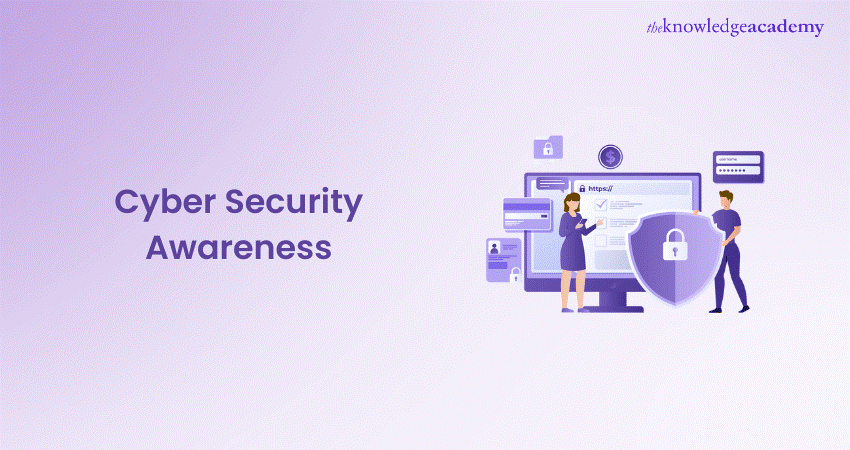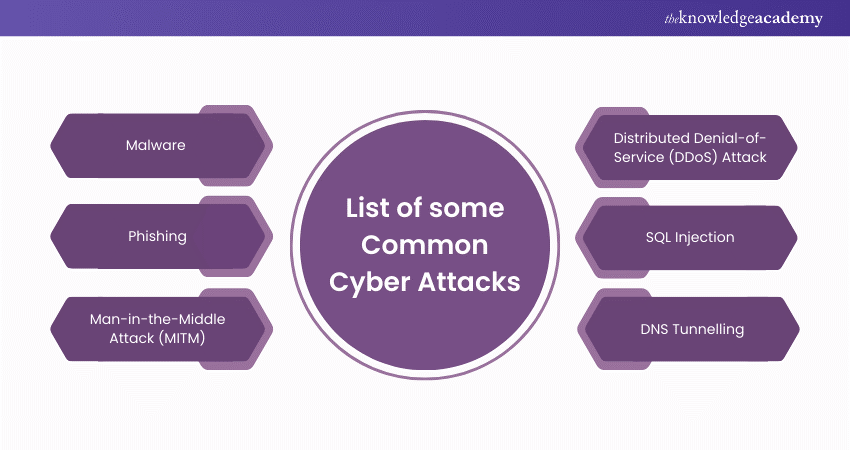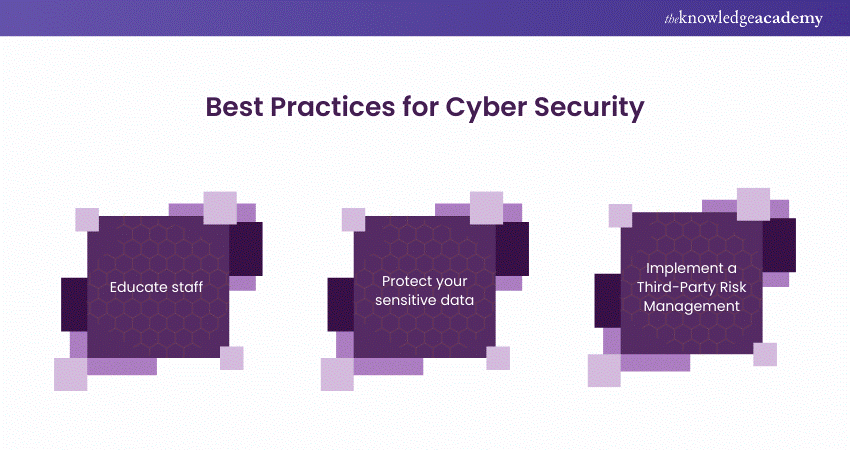We may not have the course you’re looking for. If you enquire or give us a call on + 1-866 272 8822 and speak to our training experts, we may still be able to help with your training requirements.
Training Outcomes Within Your Budget!
We ensure quality, budget-alignment, and timely delivery by our expert instructors.

Imagine opening an email that appears to be from your bank, urging you to verify your account details immediately. Feeling a sense of urgency, you click the link, only to realise it was a phishing attempt! In today's digital world, cyber threats are constantly evolving, and Cyber Security Awareness is no longer optional.
This blog dives deep into the concept of Cyber Security Awareness. We'll explore what it means to be cyber security aware and how this awareness can protect you, your devices, and your data from online threats. Cybersecurity Awareness equips you with the knowledge and skills to identify and avoid cyberattacks, safeguarding your online presence and promoting a safer digital environment for everyone. So, buckle up and get ready to learn how to navigate the web with confidence!
Table of Contents
1) What is Cyber Security Awareness?
2) Why is Cyber Security Awareness Important?
3) List of some Common Cyber Attacks
4) Essential Elements of Cyber Security Awareness
5) Cyber Security Awareness Challenges
6) What are the Best Practices for Cyber Security?
7) Conclusion
What is Cyber Security Awareness?
Cyber Security Awareness involves both understanding and acting to protect a company's information assets. When employees are aware of Cyber Security, they comprehend cyber threats, their potential impact, and the necessary actions to mitigate risk and prevent cybercrime.
Promoting a Cyber Security culture in the workplace does not completely eliminate the risk of data theft or cybercrime. Malware has evolved, becoming increasingly sophisticated with each new strain, and this trend is expected to continue.
With cyber threats growing in complexity, companies must continuously adapt their security measures. Regular employee training, robust security protocols, and constant vigilance are essential to identify and mitigate vulnerabilities, reducing the risk of cyber-attacks. Human error remains a significant risk, potentially leading to severe penalties and substantial business damage.
Why is Cyber Security Awareness Important?
Despite having top-tier protection systems and policies, many firms still experience security breaches, often due to human error. According to Verizon's 2024 Data Breach Investigations Report, almost 68 % of breaches involved the human element, including social engineering attacks, mistakes, and the misuse of stolen credentials. Cybercriminals exploit these vulnerabilities to infiltrate an organisation's networks and systems, underscoring the importance of Cyber Security Awareness.
Cyber Awareness educates employees about the malicious tactics used by cybercriminals, how they can become easy targets, how to identify potential threats, and how to prevent falling victim to these attacks. It equips employees with the knowledge and resources needed to detect and flag potential hazards before they cause any damage.
List of some Common Cyber Attacks

While an attacker can access an IT system in various ways, most cyber-attacks use quite similar approaches. Some of the most popular types of cyber-attacks are as follows:
1) Malware
Malware is a type of programme that can perform several destructive functions. Some malware strains are meant to get persistent network access, while some are designed to spy on the user in order to steal passwords or other important data. Ransomware is the most well-known type of malware. The software encrypts the victim's files and then demands a ransom payment to obtain the decryption key.
How to prevent a Malware attack?
Preventing malware attack is a difficult endeavour that requires a multi-pronged strategy. At least, you must:
a) Ensure that you have the latest anti-malware protection software installed
b) Ensure that employees are trained to identify fraudulent emails and websites
c) Use a strong password policy with multi-factor authentication (MFA)
d) Keep all software up-to-date
e) Control access to systems and closely adhere to the least-privilege concept
2) Phishing
A phishing attack occurs when an attacker tries to mislead an unsuspecting target into revealing sensitive information such as passwords, credit card information, intellectual property, etc. Phishing attacks are frequently sent in the form of an email pretending to be from a legitimate institution, such as your bank, the tax department, or another reliable source. Phishing is the most common type of cyber-attack due to its ease of execution and unexpected efficiency.
How to prevent a Phishing attack?
The techniques used to avoid phishing attacks are quite similar to preventing malware attacks. However, phishing attempts are mostly the result of a lack of attention. Security awareness training is the most effective strategy to avoid them. Employees should be adequately trained to recognise suspicious emails, links, and websites and refuse to enter information or download files from sites they do not trust. It is also a good idea to install any add-ons that can assist you in identifying malicious websites.
3) Man-in-the-Middle Attack (MITM)
A Man-in-the-Middle (MITM) attack occurs when an attacker intercepts communication between parties in order to spy on the victims, steal personal information or passwords, or alter the conversation. MITM attacks are less prevalent since most email and chat services utilise end-to-end encryption (E2EE), prohibiting third-parties from manipulating data carried across a network.
How to prevent a Man-in-the-Middle attack?
If the communication protocols you employ do not support end-to-end encryption, consider connecting to your network over a Virtual Private Network (VPN), especially if you are accessing from a public Wi-Fi hotspot. Be careful of fraudulent websites, obtrusive pop-ups, outdated certificates, and search for "HTTPS" at the beginning of each URL.
4) Distributed Denial-of-Service (DDoS) attack
A DDoS attack occurs when an attacker floods a target server with traffic to disrupt and, perhaps, bring down the target. However, unlike typical Denial-of-Service attacks, which most competent firewalls can easily detect and respond to, a DDoS attack can use numerous hacked devices to flood the target with traffic.
How to prevent a DDoS Attack?
DDoS attacks are difficult to prevent because there are few warning indications to look for and few ways to halt the attack once it has begun. However, employing a next-generation Firewall or Intrusion Prevention System (IPS) provide you with real-time insight into any traffic abnormalities, network performance difficulties, intermittent web failures, etc.
It's also a good idea to put your servers in separate data centres so that you can move to another server if the current one fails. The best way to defend your network against DDoS attacks is to have a proven and established response strategy. As it will allow you to bring your systems back online soon and maintain business operations.
Learn the fundamentals of Cyber Security. Sign up for our Cyber Security Professional Course now!
5) SQL Injection
SQL injection is a type of SQL database attack. SQL databases query data using SQL statements, commonly executed via an HTML form on a webpage. If the database permissions are not correctly specified, the attacker can use the HTML form to perform queries that create, read, edit, or remove data from the database.
How to prevent a SQL Injection attack?
The only way to avoid SQL injection attacks is to ensure that the web developers have properly sanitised all inputs. In other words, data cannot be stored directly in a database from an input box, such as a password field. The entered password must be checked to ensure that it meets predefined requirements.
6) DNS Tunnelling
DNS tunnelling is a complex attack vector that allows attackers to access a specific target permanently. Attackers can introduce or "tunnel" malware into DNS queries since many businesses fail to monitor DNS traffic for malicious activities (DNS requests sent from the client to the server). The malware is used to establish a persistent communication channel that is undetectable by most firewalls.
How to prevent a DNS Tunnelling attack?
As traditional firewalls and antivirus software cannot identify DNS tunnelling, you will likely need to invest in specialised tools such as TunnelGuard, Zscaler, and DNSFilter. You should ensure that the technologies you employ can automatically prevent the execution of malware contained in malicious DNS requests. It should ban known data exfiltration locations and perform real-time analysis of all DNS requests for suspicious patterns.
Learn the fundamentals of Cyber Security. Sign up for our Cyber Security Training now!
Essential Elements of Cyber Security Awareness
Over the years, Cyber Security Awareness training has evolved from being primarily for security professionals to encompassing IT administrators and all employees. The scope of these programmes may vary based on employee numbers, awareness levels, budget, and other factors. Regardless of scope, certain essential courses should be included in every Cyber Security Awareness training:
1) Email Security
Email is a crucial communication tool for businesses but also a major entry point for cybercrime, including phishing, ransomware, malware, and Business Email Compromise (BEC). Email security training is essential to protect employees and the business from malicious email attacks. This training helps employees recognise unsafe links and attachments.
2) Phishing and Social Engineering
The human element is a primary target for cyber attackers. Social engineering attackers exploit human behaviour and emotions to manipulate their targets into taking actions like disclosing sensitive information, granting system access, sharing credentials, or transferring funds. Training employees to detect the warning signs of phishing and social engineering attacks significantly reduces the risk of falling victim to these scams.
3) Ransomware and Malware
Malware, such as ransomware, often infiltrates organisations via phishing emails. Ransomware awareness training educates employees on how these attacks are executed, the tactics used by threat actors, and the preventive measures they can take to combat rising ransomware threats.
4) Physical Security
Maintaining physical security is crucial, even in the digital age. Employees should be aware of the risks of leaving sensitive documents, unattended computers, and passwords around the office or home workspace. Implementing a 'clean-desk' policy can significantly reduce the threat of unattended documents being stolen or copied, thus enhancing overall security.
Cyber Security Awareness Challenges
Here are some of the most common challenges to spreading Cyber Security Awareness:
a) Mitigating Cybercrime Risks: While Cyber Awareness cannot eliminate cybercrime, it is crucial for reducing potential risks. Most companies now provide some form of security awareness training, yet the prevalence of successful data breaches suggests there is still room for improvement.
b) Rapidly Evolving Threats: Cybercriminals continuously develop new attack methods, making it challenging to keep training programs current. Cyber Security training materials can quickly become outdated, as knowledge and skills effective today may not suffice against tomorrow’s threats.
c) Manual Development Process: Creating Cyber Security Awareness programs is often a manual process, unless a fully managed program is used. This involves selecting security content, creating resources, and testing training materials and tools, which can be time-consuming and burdensome.
d) Employee Engagement: Engaging employees in Cyber Security training is always a challenge. Repetitive curriculum, information overload, lengthy courses, and complex content can discourage participation, making it difficult to maintain interest and involvement.
What are the Best Practices for Cyber Security?

Here are some easy steps you can take to boost security and reduce the risk of cybercrime at your organisation:
1) Educate staff
In 2019, 90% of data breaches were caused by human error. However, this troubling figure offers a silver lining. The majority of data breach instances could be avoided if employees were educated on how to recognise and respond to cyber threats. Such educational initiatives could also increase the value of all cyber security solution investments by preventing employees from unknowingly bypassing expensive security safeguards to facilitate cybercrime.
2) Protect your sensitive data
Invest in tools that prevent information loss, monitor third-party and fourth-party vendor risk, and scan for data exposure and leaked credentials on a regular basis. If left untreated, data leaks can assist attackers in gaining access to corporate networks and breaching key resources. It is essential to develop a data leak detection solution that can also monitor leaks throughout the third-party network.
Almost 60% of data breaches are caused by compromised third-party suppliers; therefore, the vast majority of data breach instances can be averted by preventing vendor data leaks.
3) Implement a Third-Party Risk Management
Use technology to decrease expenses, such as automatically sending vendor evaluation questionnaires.
Companies should no longer question why Cyber Security is necessary but should ensure that organisations' cybersecurity procedures are enough to comply with GDPR and other legislation and safeguard firms from sophisticated cyber assaults.
Learn the fundamentals of Cyber Security. Sign up for our Cyber Security Risk Managemnt Course now!
Conclusion
In this era, the use of the internet and reliance on digital technology will skyrocket. Thus, being increasing your Cyber Security Awareness and avoidance of cyber threats is the best way to protect yourself from hackers' malicious activities.Every year, cyber security month is celebrated to raise public awareness about various sorts of attacks and the strategies people can employ to avoid becoming victims of such attacks.
Frequently Asked Questions

The main objective of Cybersecurity Awareness is to educate employees about potential cyber threats. This equips them with the knowledge and skills to identify, prevent, and respond to security incidents, thereby reducing organisational vulnerability.

Organisations can measure the effectiveness of their security awareness training through regular assessments, monitoring incident reports, conducting simulated phishing tests, and evaluating employee feedback and engagement to ensure improved security practices and reduced security breaches.

The Knowledge Academy takes global learning to new heights, offering over 30,000 online courses across 490+ locations in 220 countries. This expansive reach ensures accessibility and convenience for learners worldwide.
Alongside our diverse Online Course Catalogue, encompassing 17 major categories, we go the extra mile by providing a plethora of free educational Online Resources like News updates, Blogs, videos, webinars, and interview questions. Tailoring learning experiences further, professionals can maximise value with customisable Course Bundles of TKA.

The Knowledge Academy’s Knowledge Pass, a prepaid voucher, adds another layer of flexibility, allowing course bookings over a 12-month period. Join us on a journey where education knows no bounds.

The Knowledge Academy offers various Cyber Security Courses, including the Certified Cyber Security Professional Training, Cyber Security Awareness Course and Cyber Security Risk Management Course. These courses cater to different skill levels, providing comprehensive insights into Cyber Security Jobs
Our IT Security & Data Protection Blogs cover a range of topics related to Cyber Kill Chain, offering valuable resources, best practices, and industry insights. Whether you are a beginner or looking to advance your Cyber Security skills, The Knowledge Academy's diverse courses and informative blogs have got you covered.
Upcoming IT Security & Data Protection Resources Batches & Dates
Date
 Cyber Security Awareness
Cyber Security Awareness
Fri 17th Jan 2025
Fri 7th Mar 2025
Fri 23rd May 2025
Fri 18th Jul 2025
Fri 12th Sep 2025
Fri 14th Nov 2025
Fri 12th Dec 2025







 Top Rated Course
Top Rated Course



 If you wish to make any changes to your course, please
If you wish to make any changes to your course, please


